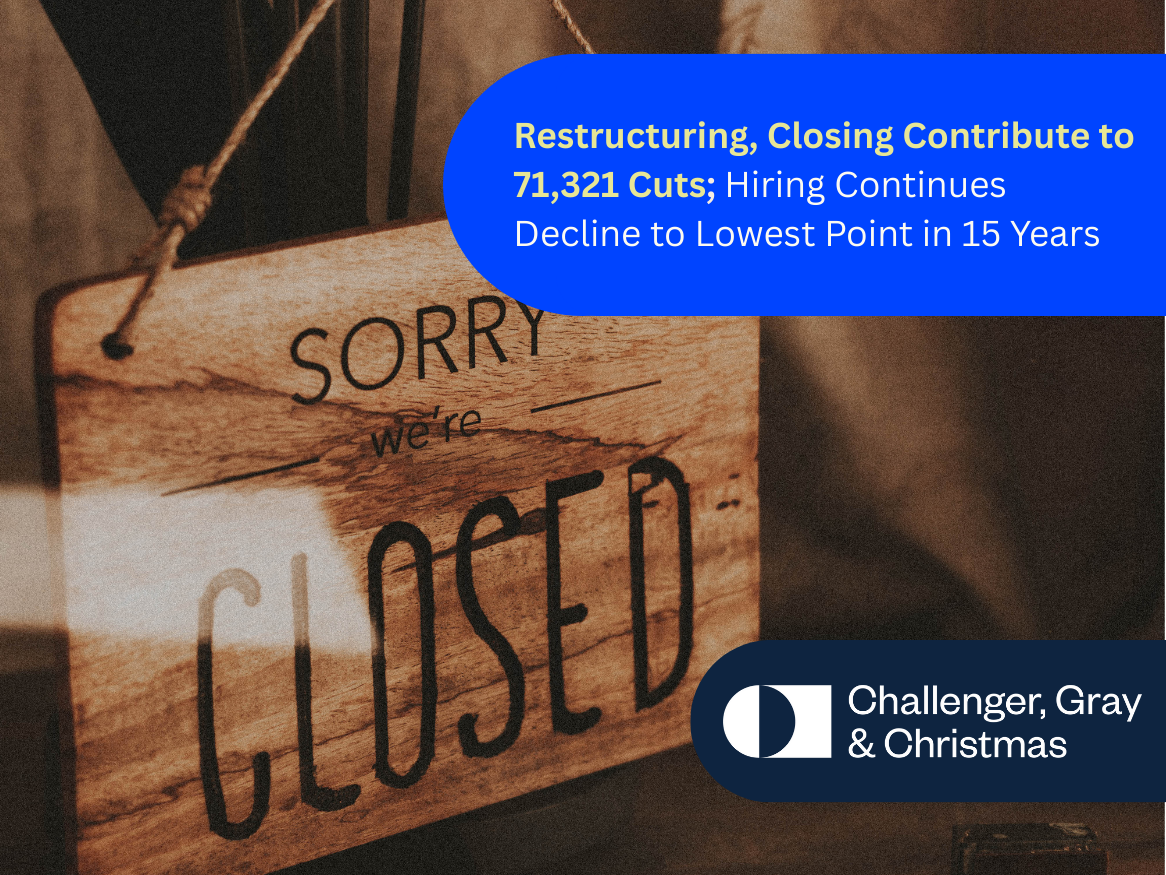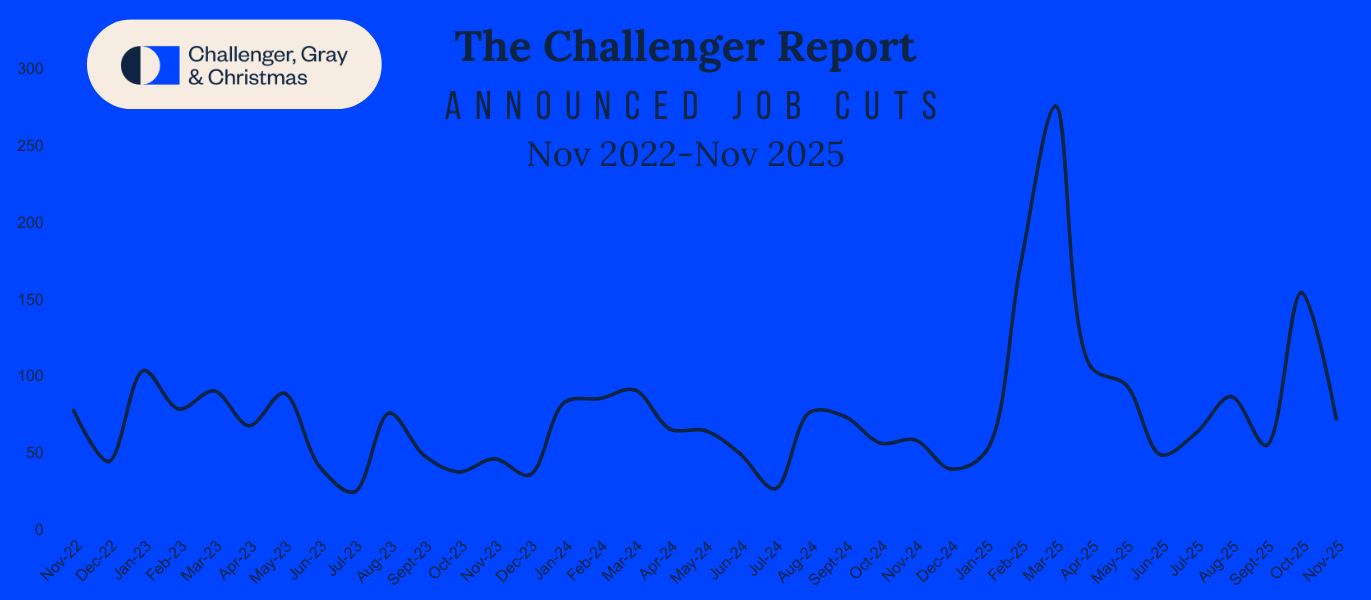
Dec 04 Challenger Report: 71,321 Job Cuts on Restructurings, Closings, Economy
NOVEMBER CUTS FALL FROM OCTOBER; UP 24% FROM NOVEMBER 2024
Published December 4, 2025
U.S.-based employers announced 71,321 job cuts in November, up 24% from the 57,727 job cuts announced in the same month last year. It is down 53% from the 153,074 cuts announced one month prior, according to a report released Thursday from global outplacement and executive coaching firm Challenger, Gray & Christmas.
November’s total is the highest for the month since 2022 when 76,835 job cuts were announced. It is the eighth time this year job cuts were higher than the corresponding month one year earlier.
“Layoff plans fell last month, certainly a positive sign. That said, job cuts in November have risen above 70,000 only twice since 2008: in 2022 and in 2008,” said Andy Challenger, workplace expert and chief revenue officer for Challenger, Gray & Christmas.

November job cuts stayed below 70,000 from 1993 until 2000, according to Challenger tracking. During the recession year of 2001, job cuts in November skyrocketed to over 181,000. Layoff plans in November remained elevated until 2009, and stayed below 70,000 until the pandemic.
“It was the trend to announce layoff plans toward the end of the year, to align with most companies’ fiscal year-ends. It became unpopular after the Great Recession especially, and best practice dictated layoff plans would occur at times other than the holidays,” said Challenger.
Through November, employers have announced 1,170,821 job cuts, an increase of 54% from the 761,358 announced in the first eleven months of last year. Year-to-date job cuts are at the highest level since 2020 when 2,227,725 cuts were announced through November. It is the sixth time since 1993 that job cuts through November have surpassed 1.1 million.
- 2020* 2,227,725
- 2001* 1,956,876
- 2002 1,373,906
- 2009* 1,242,936
- 2025 1,170,821
- 2003 1,143,406
*Indicates Recession years
WHICH INDUSTRIES ARE CUTTING THE MOST IN NOVEMBER?
Telecommunication providers announced 15,139 job cuts in November, primarily on plans from Verizon. This is the highest monthly total since April 2020 when 16,552 layoffs were announced. So far this year, the sector has announced 38,035 layoff plans, up 268% from the 10,331 announced through the same period last year.
Technology continues to lead in private-sector job cuts as Tech companies announced 12,377 in November. So far this year, these companies have announced 153,536 job cuts, up 17% from the 130,701 announced through November 2024.
Food companies, particularly those that handle beef products, announced 6,708 cuts in November. Year to date, the sector has cut 34,165 jobs, a 26% increase from the 27,060 cuts announced in the same period last year.
The Services sector, which includes companies that provide support to other businesses such as cleaning, staffing, and outsourcing firms, announced 5,509 job cuts in November, up from 1,990 in October. Year to date, the sector has announced 69,089 job cuts, up 64% from the 42,041 announced through November 2024.
Retail companies announced 3,290 job cuts in November, up from 2,431 in October. For the year, the sector has announced 91,954 job cuts, up 139% from the 38,403 cuts announced during the same period in 2024, as companies adjust workforce levels amid softening demand, tariff uncertainty, and changing consumer preferences.
Non-profits continue to be impacted by Government funding cuts as well as rising costs and lower giving trends. These entities announced plans to cut 28,696 this year, an increase of 409% from the 5,640 announced by this point in 2024.
The Media industry has announced 17,163 cuts so far in 2025, up 18% from the 14,549 cuts announced in the first eleven months of last year.
News, which Challenger tracks as a subset of Media and includes broadcast, digital, and print, has announced 2,254 job cuts so far this year, 179 of which occurred in November. For the year, News cuts are down 50% from the 4,537 cuts announced during the same period last year.
WHY ARE COMPANIES CUTTING IN 2025?
In November, Restructuring led all reasons with 20,217 for a total of 128,255 in 2025. Store, unit, or department Closing accounted for 17,140 in November, and 178,531 for the year.
Artificial Intelligence (AI) was cited for 6,280 cuts in November. So far this year, AI is responsible for 54,694 layoff plans. Since 2023, when this reason was first cited, AI has led to 71,683 job cut announcements.
Market and Economic Conditions were cited for 15,755 job cuts in November. So far this year, 245,086 job cuts have been attributed to market and/or economic conditions. Tariffs have been cited for 7,908 job cuts this year with 2,061 occurring in November.
Though the Department of Government Efficiency (DOGE) has not been the cause of job cut announcements in two months, “DOGE Impact” remains the leading reason for job cut announcements in 2025, cited in 293,753 planned layoffs so far this year. This includes direct reductions to the Federal workforce and its contractors.
An additional 20,976 cuts have been attributed to DOGE Downstream Impact, which reflects the loss of federal funding to private and non-profit entities.
HIRING PLANS IN 2025
Through November, U.S. employers have announced 497,151 planned hires, down 35% from the 761,954 announced at this point in 2024. It is the lowest year-to-date total since 2010, when 392,033 new hires were planned through November.
Included in Challenger’s hiring figure are 372,520 seasonal hiring plans through November (Table 8), the lowest number of announced seasonal hires since Challenger began tracking them in 2012. The firm did not find any new seasonal hiring plans in November.
“The increased spending over the Black Friday and the Thanksgiving weekend may give rise to hires in December right before the holiday. It’s unclear, however, if those positions will last into the New Year,” said Challenger.
